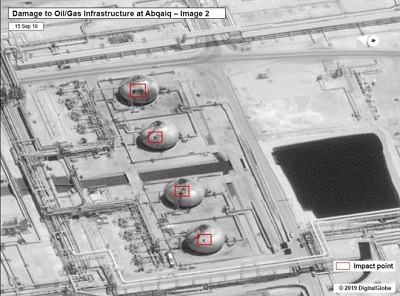
The United States has issued satellite images and cited intelligence to back its allegation Iran was behind attacks on major Saudi oil facilities.
Iran denies involvement in Saturday’s air attacks, which were claimed by Iran-aligned Houthi rebels in Yemen.
But unnamed US officials speaking to US and international media say the direction and extent of the attacks cast doubt on Houthi involvement.
The incident has cut global oil supplies by 5 per cent and prices have soared.
Secretary of State Mike Pompeo blamed Iran at the weekend, without providing any evidence, prompting Tehran to accuse Washington of deceit.
Tweeting on Sunday, President Donald Trump stopped short of directly accusing Iran, but suggested possible military action once the perpetrator was known.
Unnamed US officials have been speaking to the New York Times, ABC and Reuters.
One official said there were 19 points of impact on the targets and the attacks had come from a west-north-west direction – not Houthi-controlled territory in Yemen, which lies to the south-west of the Saudi oil facilities.
The officials said that could suggest launch sites in the northern Gulf, Iran or Iraq.
A close-up image of damaged tanks at the Abqaiq processing plant (included above) appeared to show impact points on the western side.
Other images seem to show damage at the Khurais oilfield, which is located further west.
Iraq denied at the weekend that the attacks were launched from its territory.
Prime Minister Adel Abdul Mahdi said Mr Pompeo had assured him in a phone call on Monday that the US backed Iraq’s position.
Officials quoted by the New York Times said a mix of drones and cruise missiles might have been deployed, but that not all had hit their targets at Abqaiq and Khurais.
China and the European Union have, separately, urged restraint.
In the UK, Foreign Secretary Dominic Raab said it was not yet clear who was responsible for what he described as a “wanton violation of international law”.
The oil price has seen the biggest one-day rise since the 1991 Gulf War, rising 20 per cent but falling back later.
The international benchmark used by traders, Brent crude, jumped to $71.95 (£57.53) a barrel at one point.
Prices eased after President Trump authorised the release of US reserves.
But there are concerns that higher prices could continue if tensions worsen further. -BBC




